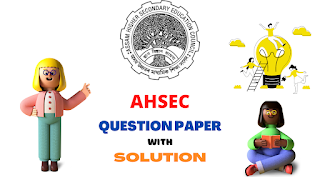ASSEB| CLASS 12| EDUCATION| SOLVED PAPER - 2025| H.S. 2ND YEAR
2025
EDUCATION
Full Marks: 100
Pass Marks: 30
Time: Three hours
The figures in the margin indicate
full marks for the questions.
1. Answer the following questions: (any twelve) 1×12=12
Fill in the
blanks:
(a) The Indira
Gandhi National Open University was established in 1985.
(b) On the
basis of the recommendation of Mudaliar
Commission Government of Assam decided to change some high schools into
multipurpose school.
(c) Prior to 1947 secondary education in Assam was
controlled by the Gauhati University and Government of Assam.
(d) The
concept of correspondence education was first introduced by Isaac Pitman in
1840.
(e) The name
of the largest Open University of the world is Indira
Gandhi National Open University (IGNOU).
(f) World
Environment Day is celebrated on 5th
June.
(g) Ivan Pavlov
was a Russian Physiologist and psychologist.
(h)
Conditioning method of learning establishes bond between natural tendency and stimulus.
Give short
answer in one sentence:
(i) Which
Education Commission suggested the 10 +2+3 structure of education?
Ans:- The
education commission that suggested the 10+2+3 structure of education was the
Kothari Commission (1964-66).
(j) "Non-formal
education differs from formal education in the sense that it takes place
outside the formal school system." Who said this?
Ans:- “Non-formal education differs from formal
education in the sense that it takes place outside the formal school system”
was stated by Combs and Ahmed.
(k)
"Physical education is the sum of changes in the individual caused by
experiences centering motor activity." Who said this?
Ans:-
“Physical education is the sum total of changes in the individual caused by
experiences centered on motor activity” was stated by Cassidy.
(l)
"Learning is both acquisition and retention of habit, knowledge and
attitude." Who said this statement?
Ans:-
“Learning is both the acquisition and retention of habits, knowledge, and
attitudes” was stated by Skinner.
(m) What is
voluntary or volitional attention?
Ans:-
Voluntary or voluntary attention is the type of attention that is exercised by
the will and requires conscious effort to focus on a particular object or task.
(n) What is
image memory?
Ans:-
Image memory, also known as eidetic memory, is the ability to recall an image
from memory with high precision after seeing it only once and without using any
mnemonic device.
(o) What is
mode?
Ans:- The mode
is the value that appears most frequently in a data set.
(p) Write the
formula for finding out first quartile from group data.
Ans:- The
formula to find the first quartile (Q1) from group data is:
where L = lower
class limit of Q1 group, N = total frequency, F = cumulative frequency before
Q1 group, h = class interval width, and f = frequency of Q1 group.
2. Answer any twelve of the following questions: 2x12=24
(a) Write two
suggestions of Kothari Commission regarding education and productivity.
Ans:- Two
suggestions of Kothari Commission regarding education and productivity:-
(i) Kothari
Commission recommended inclusion of work experience in the curriculum to link
education with productivity.
(ii) It also
suggested Vocationalisation of education at secondary level to develop skills
relevant to economic development.
(b) Write two
importance of Vocationalisation of secondary education in the present context.
Ans:- Two
importance of vocationalization of secondary education in the present context:-
(i) It equips
students with practical skills, making them employable immediately after
school.
(ii) It
reduces the mismatch between education and job market by preparing students for
specific trades or occupations.
(c) Write two
objectives of "Operation Blackboard" scheme.
Ans:- Two
objectives of "Operation Blackboard" scheme:-
(i) To provide
minimum essential facilities like classrooms, blackboards and teaching-learning
materials in primary schools.
(ii) To improve
the quality of primary education by ensuring adequate infrastructure and
resources.
(d) Define
the concept of physical education.
Ans:- Physical education is a process of education
that develops physical fitness, motor skills, knowledge and attitudes for an
active life through physical activities and sports.
(e) What do
you mean by value education?
Ans:-
Value education refers to the process of teaching and learning about ideals
that society considers important, such as honesty, respect, responsibility and
empathy, which aims to develop moral and ethical values in students.
(f) Define
the concept of women empowerment.
Ans:- Women
empowerment is the process of increasing the social, economic, political and
legal strength of women to ensure equal rights, opportunities and freedom to
make choices.
(g) Write two
differences between maturation and learning.
Ans:- Two
differences between maturation and learning:-
Maturation
(i) Maturation
is a natural, biological process of growth and development that occurs with
age.
(ii) It is
largely influenced by genetic factors and is independent of external
experiences.
Learning
(i) Learning
is a process of acquiring knowledge, skills and habits through experience,
study or teaching.
(ii) It
depends on environmental factors, experiences and practice.
(h) What do
you mean by law of readiness in learning?
Ans:- The
law of readiness states that learning takes place best when a person is
mentally and physically ready to learn; if a learner is not ready, learning
will be ineffective or may not take place at all.
(i) What is
retention?
EDUCATION SOLVED PAPERS PAGE LINK - Click here
BUY E-BOOK (PDF FILE)
[TO SEE FULL SOLUTION]
(Chapter wise Notes, Exam Question Papers solved, MCQ solved) [ARTS, COMMERCE, SCIENCE]
|
DOWNLOAD [PAGE LINK:-CLICK HERE] |
ASSEB, AHSEC PAGE LINK - CLICK HERE


